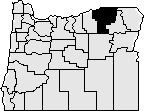
Umatilla County was created on Sept. 27, 1862, out of a portion of Wasco County. Umatilla is an Indian term meaning "rippling water" or "water rippling over sand" and has provided the name both for the county and its major river. Adjustments were made to the county's boundaries following the creation of Grant, Morrow, Union, and Wallowa Counties. The county contains 3,231 square miles and is bounded by the Columbia River and Washington on the north, Morrow County on the west, Grant County on the south, and Union and Wallowa counties on the east.
The legislative act that created Umatilla County designated Marshall Station as the temporary county seat. Umatilla City was chosen the county seat in an 1865 election. Population shifted to the north and east parts of the county due to the opening of the Pendleton area to wheat production. An election in 1868 resulted in the selection of Pendleton as the new county seat, supplanting both Marshall Station and Umatilla City.
The first courthouse was completed in 1866 in Umatilla City. The next courthouse, and the first built in Pendleton, was a wooden, 2-story structure completed in 1869. In 1889 a 3-story brick courthouse and jail was erected. A 4th courthouse was built on the site of the old courthouse in 1956 and is still in use today.
The government of Umatilla County consisted originally of a county judge, two county commissioners, clerk, and sheriff. The offices of treasurer, assessor, coroner, and superintendent of schools were added a short time after formation of the county. The county judge position was abolished and a third commissioner was added in 1975. Umatilla County adopted a "home rule" charter in 1993, which gives the county more local discretion in its management.
The first census of the Umatilla County in 1870 counted 2,916 inhabitants. The population has increased steadily with a 2016 census figure of 79,880 representing an increase of 5.3% over 2010. Much of the recent growth has come to the Hermiston area.
The Umatilla Indian Reservation was established by the Treaty of Walla Walla in 1855. It became an 800 square mile home for the Umatilla, Walla Walla, and Cayuse tribes and is located immediately southeast of Pendleton. The Umatilla Confederated Tribes have over 3,000 enrolled members.
The Lewis and Clark Expedition and later travelers of the Oregon Trail passed through the area. The gold rush of 1862 brought miners and stock raisers to the mountains and grasslands of Umatilla County. The county expanded after the coming of the railroad in 1881 and the area was open to the development of dry land wheat farming. The fertile land of Umatilla County gives a strongly agricultural base to the county's economy. Fruit, grain, timber, cattle, and sheep are important agricultural products. Transportation-related industries have grown in the Hermiston area in recent years. Recreation, primarily in the Blue Mountains, and tourism, most notably for the annual Pendleton Round-Up rodeo, are also important to the local economy.